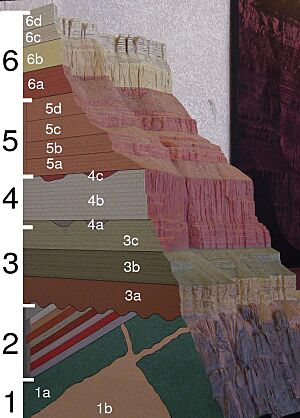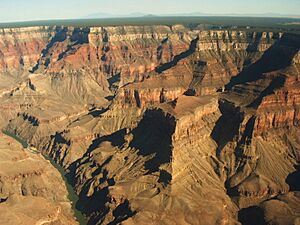Geological formation facts for kids

A rock formation is a basic unit that geologists use to describe different types of rocks found in layers. Think of it like a chapter in a very old book, where each chapter is made of different kinds of rock.
These formations are made up of several rock layers, called strata. These layers often have similar rock types (called lithology) or look alike (called sedimentary facies). Formations are not defined by how thick they are, so some can be very thin, and others can be incredibly thick!
The idea of these formally defined rock layers is super important in stratigraphy, which is the study of rock layers. A formation can be broken down into smaller parts called 'members'. Several formations can also be grouped together into larger units called 'groups'.
Geologists first used formations to help tell time, based on how old rocks are compared to each other (relative dating) and the idea that older layers are usually at the bottom (law of superposition). By studying these formations, geologists from the 18th and 19th centuries were able to put together a timeline of Earth's history.
Rock formations are created when sedimentary materials like sand, mud, or tiny bits of shells settle and build up over millions of years. This process is called deposition. For example, in Western Australia, there's a place called the Hammersley Basin. Here, you can find rock layers that show how sediments were deposited for up to 1.2 billion years! Some parts of this basin have single rock units, like banded iron formation and shale, that represent 300 million years of Earth's history.
How Rock Layers are Organized
Geologists organize rock layers from largest to smallest like this:
- Stratigraphic groups (the biggest sections)
- Formations (the main units we're talking about)
- Members (smaller parts within a formation)
- Stratum (the smallest individual rock layer)
- Members (smaller parts within a formation)
- Formations (the main units we're talking about)
Images for kids
-
The rock layers from the Permian to the Jurassic periods in the Colorado Plateau area of southeastern Utah.
-
The Summerville Formation has thin, alternating layers of mudstone and sandstone, with veins of gypsum running through them.
See also
 In Spanish: Formación geológica para niños
In Spanish: Formación geológica para niños





